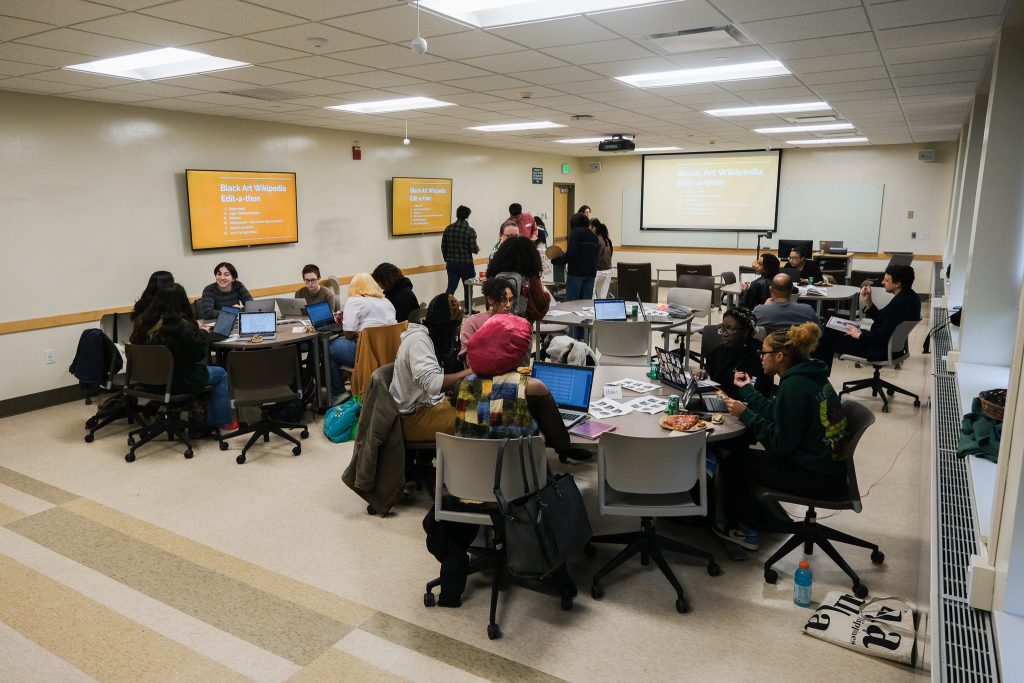Multiple on-campus organizations and undergraduate students put their heads together to expand accessible knowledge on Wikipedia of six underrepresented Black artists last Friday. The Wikipedia Edit-a-Thon was a collaborative effort between the Binghamton University Art Museum (BUAM), the BU Libraries and the students in the undergraduate course ENG 390A: Black Women and Creativity (1960-1980), also cross-listed as an Africana studies and art history class.
The Edit-a-Thon was held in Classroom Wing room 112 from 5 p.m. to 7 p.m. The group had one mission — to provide representation for and bring information about Sherman Beck, Loretta Pettway Bennett, LaToya Hobbs, Howardena Pindell, Alison Saar and Ed Wilson to Wikipedia. During the Edit-a-Thon, several presentations were given on the impact that Wikipedia editing can have on communities, and then the group worked to parse through scholarly texts for information before editing the Wikipedia articles.
Jennifer Stoever, associate professor of English and the instructor of ENG 390A: Black Women and Creativity (1960-1980), wrote that many of the Wikipedia pages were sorely lacking in information before the event began.
“When we looked up the Wikipedia pages for four of the artists who were active in the era of our class, Loretta Pettway Bennett, LaToya Hobbs, Howardena Pindell [and] Alison Saar, we were shocked at how bare they were,” Stoever wrote in an email. “It was really eye-opening. Because it’s freely [accessible] and has been with us for awhile now, Wikipedia is something we all take for granted, but it is the 10th most-visited site in the world and the number one ‘first place’ we learn about the world online, but it’s only as good — and only as diverse — as the people writing it.”
Despite the site’s close to 10 billion views each month, many of the articles were between two sentences long to little more than stubs — a type of Wikipedia article that is too short to be deemed full coverage of a given subject. The Edit-a-Thon also brought light to wider issues of representation within and outside of online spaces.
Claire Kovacs, the curator of collections and exhibitions at the BU Art Museum, shared other reasons why events like these are important to the artists themselves and to the communities that run them.
“Events like the Edit-a-Thon are a way to deepen and amplify the stories that are shared and told, and celebrate [the artists’] history,” Kovacs wrote in an email. “As the organization Art + Feminism tells us — ‘When cis and trans women, non-binary people, Black, Indigenous and people of color communities are not represented in the writing and editing on the 10th-most-visited site in the world, information about people like us gets skewed and misrepresented. The stories get mistold. We lose out on real history.’”
Stoever generally agrees with this conclusion. She wrote that these events bring a presence of Black artists into spaces where they otherwise wouldn’t have one, and give them representation far beyond our local community.
“Events like the Edit-a-Thon are important because white gatekeepers have kept Black women artists from their just due in the art world for years and Wikipedia reflects that too,” Stoever wrote. “Black women artists deserve their flowers in the present and an enduring place in history. Wikipedia is one place where we can help do that and have a global impact.”
It wasn’t just the BU Art Museum, the Binghamton Libraries and Stoever who can be given credit for organizing such a powerful event. Stoever’s students had a large hand in the organization of the event as well. Lourdes Sares-McCabe, a senior at majoring in art history, wrote that the Black Women and Creativity (1960-1980) class has been an entirely unique experience.
“I have never had the pleasure of engaging in a project like this,” Sares-McCabe wrote in an email. “The way that Professor Stoever has structured her course is reflective of the desire to create a lasting change not only in our awareness of these [artists’] impact but also the impact that we can have on their memory as archivists.”



